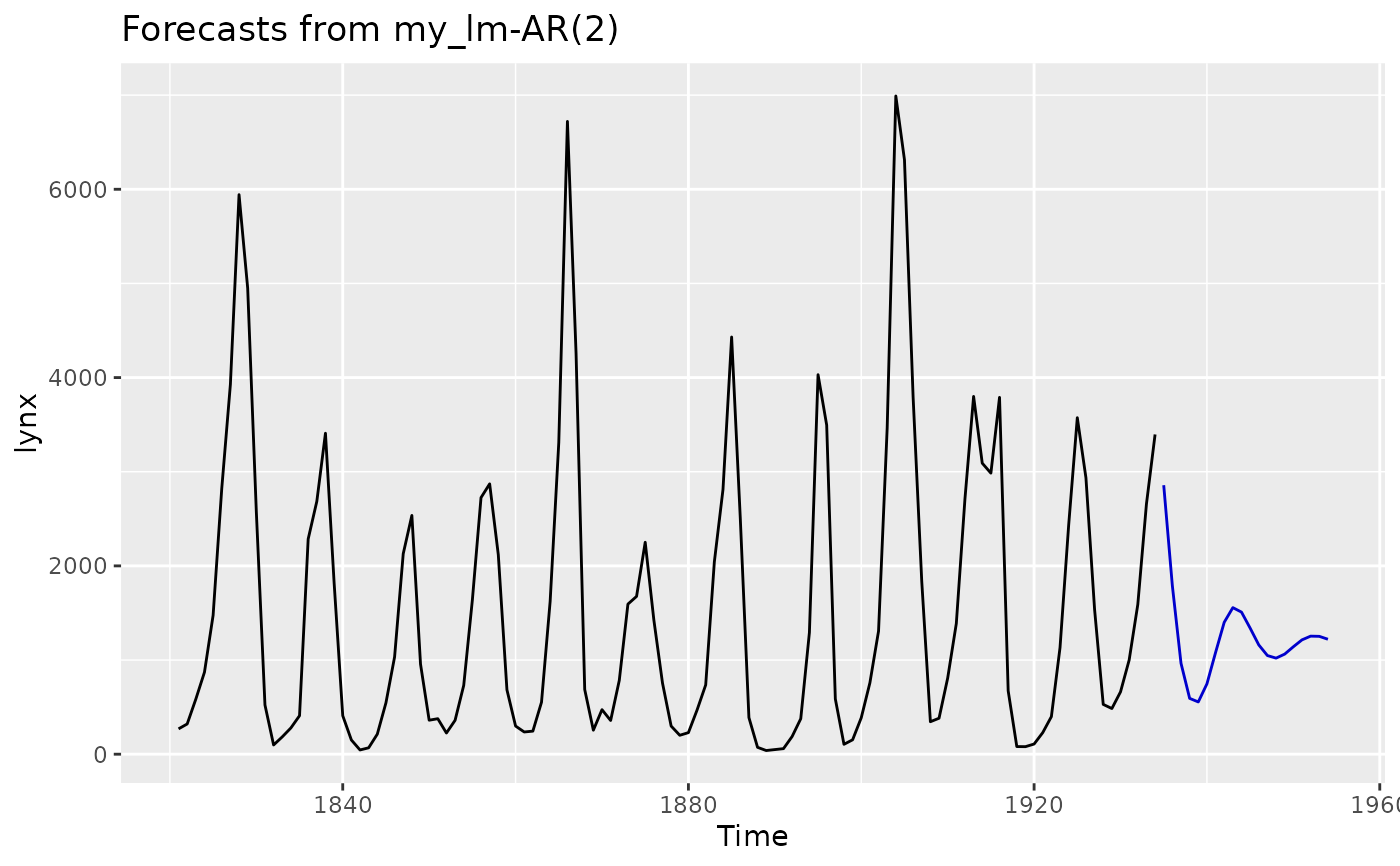Experimental function to forecast univariate time series with a user-defined model
Usage
modelAR(
y,
p,
P = 1,
FUN,
predict.FUN,
xreg = NULL,
lambda = NULL,
model = NULL,
subset = NULL,
scale.inputs = FALSE,
x = y,
...
)Arguments
- y
a numeric vector or univariate time series of class
ts- p
Embedding dimension for non-seasonal time series. Number of non-seasonal lags used as inputs. For non-seasonal time series, the default is the optimal number of lags (according to the AIC) for a linear AR(p) model. For seasonal time series, the same method is used but applied to seasonally adjusted data (from an stl decomposition).
- P
Number of seasonal lags used as inputs.
- FUN
Function used for model fitting. Must accept argument
xandyfor the predictors and response, respectively (formulaobject not currently supported).- predict.FUN
Prediction function used to apply
FUNto new data. Must accept an object of classFUNas its first argument, and a data frame or matrix of new data for its second argument. Additionally, it should return fitted values when new data is omitted.- xreg
Optionally, a numerical vector or matrix of external regressors, which must have the same number of rows as
y. It should not be a data frame.- lambda
Box-Cox transformation parameter. If
lambda = "auto", then a transformation is automatically selected usingBoxCox.lambda. The transformation is ignored if NULL. Otherwise, data transformed before model is estimated.- model
Output from a previous call to
nnetar. If model is passed, this same model is fitted toywithout re-estimating any parameters.- subset
Optional vector specifying a subset of observations to be used in the fit. Can be an integer index vector or a logical vector the same length as
y. All observations are used by default.- scale.inputs
If
TRUE, inputs are scaled by subtracting the column means and dividing by their respective standard deviations. Iflambdais notNULL, scaling is applied after Box-Cox transformation.- x
Deprecated. Included for backwards compatibility.
- ...
Other arguments passed to
FUNformodelAR.
Value
Returns an object of class modelAR.
The function summary is used to obtain and print a summary of the
results.
The generic accessor functions fitted.values and residuals
extract useful features of the value returned by modelAR.
- model
A list containing information about the fitted model
- method
The name of the forecasting method as a character string
- x
The original time series.
- xreg
The external regressors used in fitting (if given).
- residuals
Residuals from the fitted model. That is x minus fitted values.
- fitted
Fitted values (one-step forecasts)
- ...
Other arguments
Details
This is an experimental function and only recommended for advanced users.
The selected model is fitted with lagged values of y as inputs. The inputs are for lags 1 to p, and lags mtomPwherem = frequency(y). If xregis provided, its columns are also used as inputs. If there are missing values inyorxreg`, the corresponding rows (and any others
which depend on them as lags) are omitted from the fit. The model is trained
for one-step forecasting. Multi-step forecasts are computed recursively.
Examples
## Set up functions
my_lm <- function(x, y) {
structure(lsfit(x,y), class = "lsfit")
}
predict.lsfit <- function(object, newdata = NULL) {
n <- length(object$qr$qt)
if(is.null(newdata)) {
z <- numeric(n)
z[seq_len(object$qr$rank)] <- object$qr$qt[seq_len(object$qr$rank)]
as.numeric(qr.qy(object$qr, z))
} else {
sum(object$coefficients * c(1, newdata))
}
}
# Fit an AR(2) model
fit <- modelAR(
y = lynx,
p = 2,
FUN = my_lm,
predict.FUN = predict.lsfit,
lambda = 0.5,
scale.inputs = TRUE
)
forecast(fit, h = 20) |> autoplot()

